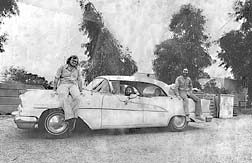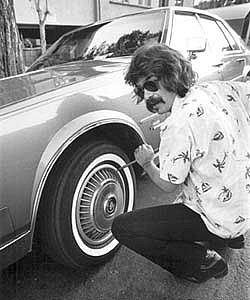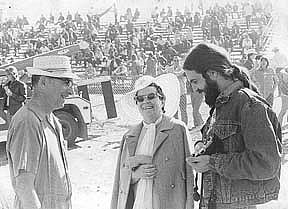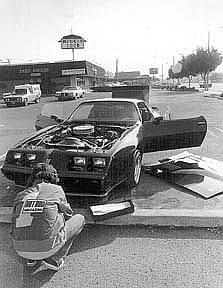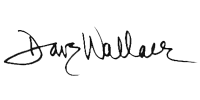|
|
||||
|
||||
|
"These are not things that just any photographer could have done without a considerable amount of photographic knowledge," added Thompson. Moreover, digital photos were of no use to publications unable to receive them -- and few were thus equipped in 1991. Not every editor and bean-counter was anxious to embrace the biggest change in photographic processes since the invention of film. Where possible, Ron would invite himself right into a newsroom to teach staffers how to work with the digital images he was sending around the world. He taught himself PhotoShop, becoming an early expert in creative uses of the software, then helped art departments install the program. "By 1993 or '94, some of those same publications would accept nothing but digital images," said Thompson, chuckling. Whenever I see one of Nikon's sexy new D-1 cameras at the track, I think of the ancestral Nikons that Ron would bring to NHRA events at Pomona. The first one was valued at more than $25,000, and nobody could buy one. Surrounded by a gaggle of film photographers, Ron would patiently explain the latest technology and share printed examples of his digital work. He correctly predicted that an affordable SLR camera, which would accept our old Nikon lenses, would be a reality by the turn of the century. The D-1 is that camera. Hussey hung around just long enough to see it happen. At the time of his death, he was shooting the majority of his assignments in digital form exclusively. Had our working relationship been the extent of it, I wouldn't feel nearly as bad as I do tonight. It's been three months, to the day, since a neighbor found my lifeless friend on the floor of the Long Beach home that Ron and Annie were buying. Cause of death was a ruptured esophagus. Ron was 50 years old; one month younger than me. During the latter half of his half-century here, Ron was responsible for helping form many of my fondest memories.
He rode with me to Van Nuys Boulevard in my '55 Olds the night that a Hot Rod staffer advised me of a possible job opening. The Drag News crew had RSVP'd back to a dinner invitation issued by Hot Rod to motorsport-media types. Our intent had been merely to eat a free meal at some fancy restaurant, load up on free cocktails, then observe and ridicule the new-model, underpowered vans that would be staging a nighttime-cruise scene for the magazine and Ford Motor Company. Instead, that evening changed my entire life. All the way home, my pal pumped me full of confidence, convincing me that I did, in fact, have the right stuff to fill the shoes of my journalistic heroes at Hot Rod. Another night, Ron and I met at a tiny club in Huntington Beach for a John Prine concert. Between sets, our respective girlfriends, who had just been introduced, went to the restroom together. By the time they returned, my future wife had been invited to apply for the assistant-art-director's position that would change her life, and mine. (Less lucky was art director Elaine Anderson, whose illegally parked VW was being towed from behind the club at approximately the same time.) More than two decades later, Connie Strawbridge and I trace the origin of our advertising and publishing company, Good Communications Inc., to that evening at the Golden Bear.
John Prine was Ron's favorite singer-songwriter, and mine. When I received permission from Prine and his management to interview him for Hot Rod, I brought Ron along as official photographer. What was scheduled as a one-hour session at Electra Record headquarters, under the protective eyes of a Hollywood PR type, turned into a wild afternoon, evening and early morning of cruising and partying with our musical hero. Prine turned out to be a lifelong Hot Rod reader who asked as many questions about our careers as we did about his.
Then there was the time that Ron was literally run over by the famous motocross racer who pulled a giant wheelie on the last lap, lost control, then crashed into and over a chain-link fence lined with spectators. The one person who took a direct hit was Hussey, who'd been standing in a group of young kids, shooting up what remained of his final roll of film. The ambulance ride to a Stockton hospital over bumpy dirt roads inflicted even more pain than had the speeding motorcycle. Once there, a physician named Dr. Lucky (no lie!) X-rayed Ron, detected no injuries, and pronounced him well enough to ride the eight hours home. It would be days before a local hospital discovered several broken bones, among other injuries. A series of major surgeries followed, keeping Ron hospitalized for weeks. There were two things he couldn't get in that hospital. Both had their roots in Mexico, you might say. One of them was legal: Mexican food. Both substances were regularly smuggled into his room and secretly consumed on the night shift, when a skeleton crew was less likely to investigate. These friends also procured tickets to a Burbank concert of another musical favorite, a little-known female singer. Scheduled for the same week as the hospital's most-optimistic release date, the date inspired Ron to enthusiastically participate in physical therapy, as we'd intended. When the day finally came, everyone except Hussey could plainly see that this patient was in no shape to leave that hospital. Ron insisted, so his pals appropriated a wheelchair and busted him out of there, against doctors' orders. We must've pushed that chair a mile that day, but wound up right in front of the stage. By the end of the concert, Bonnie Raitt was singing directly to our wounded comrade, as if Ron were the only member of the audience. He was literally jumping out of his chair, singing along with Bonnie. That's one of the audio-visual images that clicks into place, like slides in a slide show, whenever I think of Ron.
I can't look at a salted margarita glass without thinking of my friend. Like so many of the wild-and-crazy characters I've met in this business over four decades, Ron Hussey was determined to enjoy the journey, regardless of whatever shrapnel might be tossed in his direction. He shrugged off every setback with loud laughter and premium tequila. My friend managed to go an entire lifetime without growing up. He went directly from shooting a collection of World War II airplanes with his oldest friend, fellow-photographer Dave Hahs, to the great beyond. Ron actually pulled it off. One of these days, when I stop feeling so damn sad, I'm gonna mix up a margarita and have a good laugh about that.
Dave Wallace Jr. is a washed-up photojournalist and magazine editor who co-owns Good Communications, Inc. a full-service advertising agency (goodcom@goldrush.com). Wallace also publishes the Hot Rod Nostalgia "magalog" (www.hotrodnostalgia.com). Volume Five of the print version is currently in production.
Photo by Rollo Tomassi |
||||
|
||||

